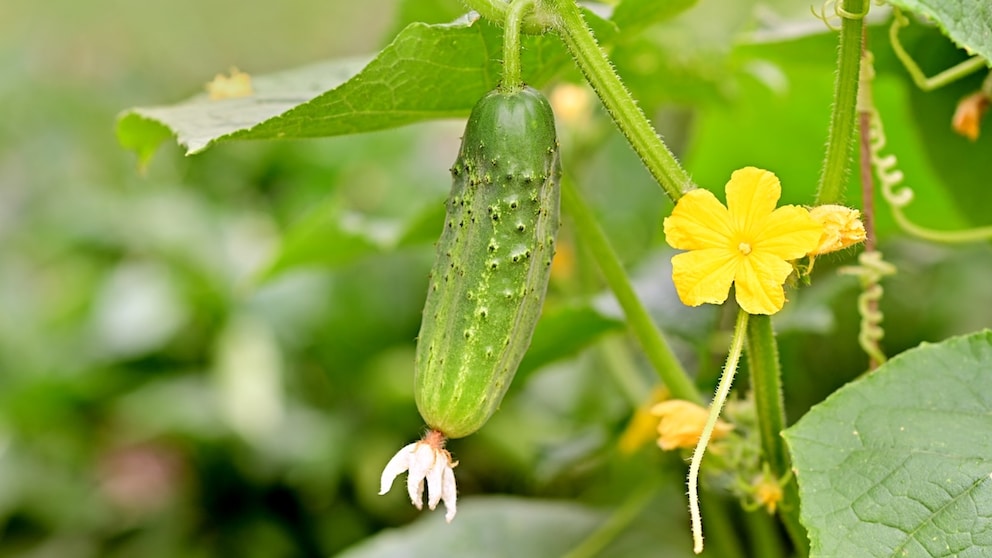April 12, 2025, 9:40 am | Read time: 5 minutes
Cucumber diseases such as mildew, leaf spot, or gray mold can quickly become a challenge. Here on myHOMEBOOK, we reveal how you can recognize these diseases, protect your plants, and react in an emergency.
Cucumbers are among the favorites in the vegetable garden but are unfortunately susceptible to a whole range of diseases. Whether fungal infections, viruses, or bacteria — damage can be minimized with targeted prevention and quick action. Here are six typical cucumber diseases.
One of the Common Cucumber Diseases: Downy Mildew
Downy mildew is one of the most common diseases that affects the cucumber plant. The first signs of the fungal infection are angular yellow spots on the upper side of the leaves, bordered by the leaf veins. They gradually turn brown before the leaf dies back from the edge. Brownish-purple coatings appear on the underside of the leaves. The fungus is spread by wind, especially on cool, damp nights with dew formation. Resistant varieties, sufficient plant spacing, and trellises help to prevent it. The plants should also be fortified with diluted horsetail plant extract, and it’s important to avoid wetting the leaves during watering. Good ventilation in the greenhouse reduces the formation of dew. Infested leaves should be removed and disposed of early to prevent the infection from spreading. In addition, spraying with garlic decoction and baking soda solution can support the plants.
Powdery Mildew
It’s not easy to please cucumbers: while downy mildew threatens in damp weather, powdery mildew strikes in sunny, dry weather. The latter manifests itself as a whitish, powdery, wipeable coating that first appears in spots on the upper side of the leaf. Over time, the coating spreads until the entire leaf surface is covered with a mealy sheen. The leaves gradually die underneath. Prevention can be achieved by spacing plants further apart and using resistant varieties. Home remedies like a diluted mixture of cow’s milk and water (1:8) or a baking soda solution can be effective against an infestation. Spray the infested leaves regularly over several days, preferably when it is cloudy. If the infestation is severe, it is often only possible to remove the plants.
Mosaic Spot Disease
Mosaic spot disease is caused by the cucumber mosaic virus and is characterized by yellow-green, mosaic-like discolorations on the leaves. Initially, the disease is easily confused with downy mildew, but while the leaves of downy mildew quickly become brownish and dry over a large area, they tend to curl up in the case of the virus disease. Infected plants often suffer from stunted growth and wilting and have deformed leaves and fruit. This disease is transmitted to cucumbers by aphids. Prevention can, therefore, be achieved primarily through early control of the vectors. Choosing resistant varieties can also help. Once the disease has broken out, there is no cure. Infested plants must be completely removed and disposed of so that the disease cannot spread.
Angular Leaf Spot Disease
Angular leaf spot disease is caused by bacteria and is spread via infected seeds, wind, rain, or contaminated garden tools. The bacteria penetrate the plant through injuries, for example, caused by pests or harvest cuts. Clean garden tools, therefore, help to prevent the disease, as do a wide crop rotation and the use of healthy seeds. The disease manifests itself as angular, glassy-yellow spots on the leaves, which enlarge, turn brown, dry out, and eventually fall out. Slimy secretions may appear on the undersides of the leaves and on the fruit. There is no cure. Infested plants must be completely removed immediately to prevent further spread.
Cucumber diseases in the Greenhouse: Gray Mold
Gray mold is characterized by a grey, velvety coating on leaves, stems, flowers, and young fruit, which makes them inedible. The fungus mainly occurs in greenhouses with high humidity, whereas it is rare outdoors. Weakened plants are particularly susceptible, for example, due to injury or stress, such as lack of water. Good ventilation, watering close to the soil, and disinfecting tools help prevent the disease. Infested parts should be removed immediately. Treatments such as garlic tea, baking soda solutions, or horsetail plant extract can also be beneficial.

Planting and caring for blackcurrants in the garden

Growing Cucumbers on the Balcony – How to Harvest Successfully

How Savoy Cabbage Is Grown in the Garden
Cucumber Wilt
Cucumber wilt is caused by various fungi such as Fusarium, Verticillium, or Sclerotinia and mainly occurs in greenhouses under humid conditions. The plants suddenly begin to wilt even though there is sufficient water. The reason is that the fungi penetrate the vascular system of the stems and clog them, blocking the transport of water. There is no known cure. Infected plants must be disposed of completely. Preventative measures include taking a break from cultivating cucumbers for at least four years, choosing resistant varieties, providing diligent care, and selecting an appropriate location.

